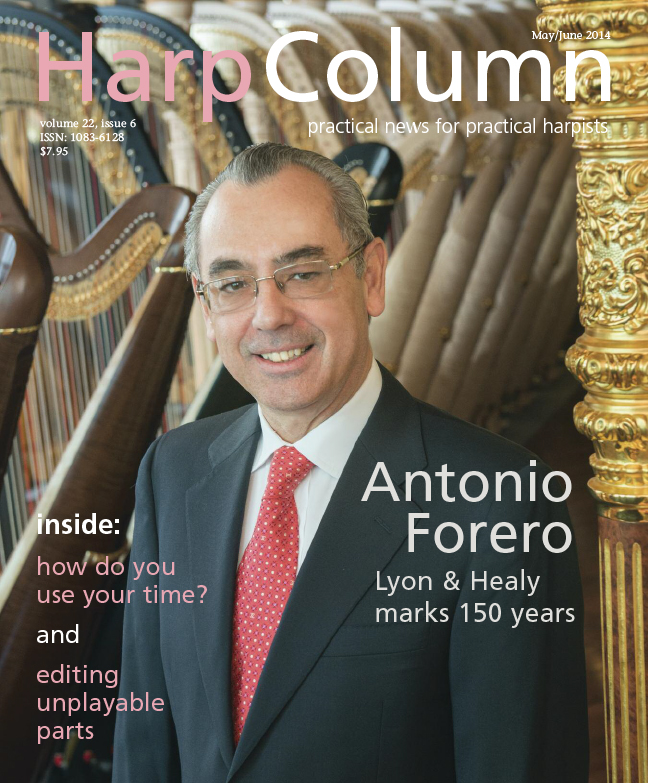—by Natalie Salzman
Plan B for your career might just hold the fairytale ending.
Double-park on 141st, run inside to wheel my harp out, hope the local street gang will take pity on me and help me with the stairs, and pray to God it’s not raining. This was my weekly, sometimes daily, routine this summer while performing in New York City. After graduation last May from Indiana University, I was ecstatic to be out in the real world, earning my keep and making it as a musician. I imagined I’d live like Rodolfo and Mimi in a tiny roof-top apartment, overlooking the city scene as we huddled by the furnace, arguing over philosophy, art, and poetry. Oh, how romantic and Bohemian it would all be, assuming tuberculosis was no longer an imminent threat. Well, that fantasy was short-lived.
[pullquote]Follow Natalie: Want to hear Natalie Salzman’s original music? Check out her website at nataliesalzman.com.[/pullquote]
One day early in that first summer in the real world, I burst into tears, realizing that it was far more difficult than I thought to make a career, let alone support myself, with the harp. My fears were exacerbated by a tendonitis injury several months earlier, which prevented me indefinitely from playing classical music. Since medical school seemed too much of a hassle, and I wasn’t keen on moving back home with my parents and working at the DMV, I decided I better find a way to make it work with this harp degree.
[protection_text]
Though I was classically trained, I had a deep passion for playing and singing blues and country music on the harp, which I had done for fun over the past year. Luckily, this less technically demanding music didn’t aggravate my tendonitis. So I exchanged my Renié for Ray Charles and started building up a repertoire of tunes. However, as I began to book shows at coffee shops, bars, and music clubs in NYC, most places required original music. So I confidently told the booking agents that I was a veteran singer/songwriter and had at least an hour set of original songs. Then, I locked myself in my room for two weeks and started writing for the first time.
After two weeks, I had put together an hour set of original songs and arrangements, and embarked upon my journey in New York City. My first show was at a place called the Cornelia Street Café, which has been a cornerstone of the Village songwriter scene since 1977. Keep in mind that I had never performed my own songs or sung in front of an audience, so I was undeniably nervous but excited beyond belief.
Three months later summer was over, and I could look back on an amazing season filled with live music and a community of new songwriter friends. Most of all though, I had grown as an artist. I started taking songwriting more seriously, putting great effort in crafting songs and composing harp arrangements. I enjoyed the challenge of taking a pioneering approach to the harp and adapting new genres to the instrument. I loved the ability to manipulate the audience emotionally with my music.
The next logical step was to be to professionally record my songs in a studio, so that I would have a proper representation of my music. Coincidentally, I went to a screening of a documentary titled “Muscle Shoals” at a local film festival back home in late August. I had never heard of this tiny town—Muscle Shoals, Ala.—or the legendary studio that produced some of the most iconic hits over the past 50 years. However, the soundtrack of the documentary was the soundtrack of my childhood. This was the music I had grown up on. Famous for the “Muscle Shoals sound,” local recording studios produced hit records here that shaped the history of popular music. Since the 1960s, artists such as Aretha Franklin, Etta James, The Rolling Stones, Lynyrd Skynyrd, Paul Simon, Bob Dylan, the Allman Brothers, Rod Stewart, Eric Clapton, Bob Dylan, Linda Rondstadt, Jimmy Cliff, Clarence Carter, Sonny and Cher, Bob Seger, Willie Nelson, Alicia Keys, the Civil Wars, and many more have made the pilgrimage to Muscle Shoals to find and hone their sound. I fell in love with the story and the music, and I knew I had found the studio where I wanted to record my debut album. So the next morning, I called them up and booked several days of studio time. I asked if the original session artists from the 60s and 70s, known as “the Swampers,” were still recording. I was in luck. Most of them still lived nearby in Alabama and could play on my album.
One month later, I drove from New York City to Muscle Shoals. My time in the studio was one of the most amazing experiences I’ve ever had. The musicians, who were well into their 60s and 70s, were some of the kindest, most talented, and inspiring musicians I’ve ever worked with. As a result, one week in the studio turned into one month, and a three-song demo turned into an album with seven fully-produced songs. I learned what it meant to be a recording artist, how to produce an album, and how to be an entrepreneur of your own music career. It was hard to believe that several months earlier, I had locked myself up in my room to write some songs and was now recording an album with legendary session musicians. There was no turning back now.
Life after music school may not have turned out to be the idealistic bohemian one I dreamed up for myself like in La Bohème, but I loved it nonetheless with all the hardships and struggles. Unloading the harp in Harlem at 2:00 a.m., moving the harp through a blizzard, and driving 16 hours cross country in one day to re-record a song in the studio is just part of the experience. Your art is an expression of you, and your success, however it may be defined, is a measure of talent and perseverance. Turn every obstacle into an opportunity and you will have a chance of making it as an artist. •
Natalie Salzman is a classically-trained harpist and singer/songwriter based in Nashville, Tenn. Originally from Boston and Israel, she studied with Susann McDonald at Indiana University.







